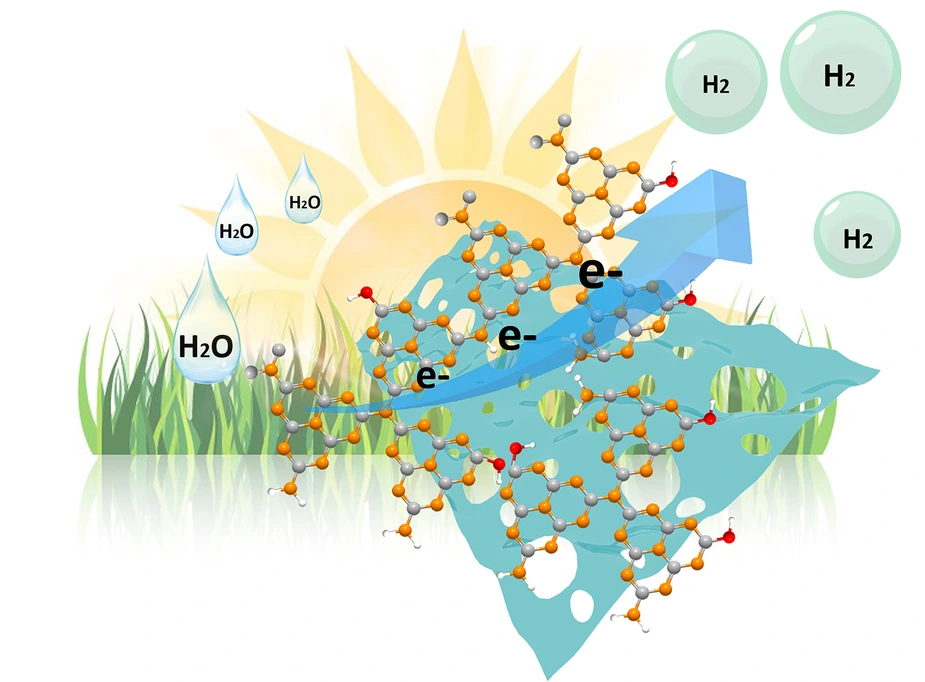Important progress in solar-to-hydrogen conversion
Nanostructuring increases efficiency of metal-free photocatalysts by factor eleven
Polymeric carbon nitrides exhibit a catalytic effect in sunlight that can be used for the production of hydrogen from solar energy. However, the efficiency of these metal-free catalysts is extremely low. A team at the Tianjin University in China, in collaboration with a group at the Helmholtz-Zentrum Berlin, has increased the catalytic efficiency of these polymeric carbon nitrides by a factor eleven through a simple process resulting in a larger surface area. The paper was published in the journal Energy & Environmental Science.
One of the major challenges of the energy transition is to supply energy even when the sun is not shining. Hydrogen production by splitting water with the help of sunlight could offer a solution. Hydrogen is a good energy storage medium and can be used in many ways. However, water does not simply split by itself. Catalysts are needed, for instance Platinum, which is rare and expensive. Research teams the world over are looking for more economical alternatives. Now a team headed by Dr. Tristan Petit from the HZB, together with colleagues led by Prof. Bin Zhang from Tianjin University, Tianjin, China, has made important progress using a well-known class of metal-free photocatalysts.
Nanolayers with large pores
Bin Zhang and his team specialise in the synthesis of polymeric carbon nitrides (PCN) that is considered a good candidate as a catalyst for hydrogen production. The PCN molecules form a structure that can be compared to thin layers of filo pastry dough: sheets of this material lie on top of each other tightly packed together. The Chinese chemists have now succeeded by means of a relatively simple two-step heat treatment in separating the individual sheets from each other – the same way that puff pastry separates into individual crispy layers in the oven. The heat treatment produced samples consisting of individual nanolayers with large pores containing different amino groups with specific functionalities.
Amino- and oxygenated groups analysed at BESSY II
Petit and his team investigated a series of these PCN samples at BESSY II. “We were able to determine which amino and oxygenated groups had been deposited in the pores”, PhD-student Jian Ren and co-first author of the publication explains. They could analyse how specific amino groups pull electrons to themselves, a particularly favourable property for splitting water, and how new oxygen-based defects were formed.
Efficiency increased by factor eleven
When combined with nickel as a co-catalyst, those samples of nanostructured PCN actually exhibited record-breaking efficiency, eleven times that of normal PCN under visible light irradiation.
Photocatalytic processes at BESSY II unraveled
“This demonstrates that PCN is an interesting potential catalyst for solar-to-hydrogen production, approaching the efficiency of inorganic catalysts”, explains Petit, who is a Volkswagen Foundation Freigeist Fellow. “Furthermore, this work also shows that soft X-ray spectroscopies are essential tools to unravel possible catalytically active sites on photocatalysts.”
Published inEnergy&Environmental Science (2018): Engineering oxygen-containing and amino groups into two-dimensional atomically-thin porous polymeric carbon nitrogen for enhanced photocatalytic hydrogen production
Nannan Meng, Jian Ren, Yang Liu, Yi Huang, Tristan Petit & Bin Zhang, DOI: 10.1039/C7EE03592F
Contact:
Helmholtz-Zentrum Berlin für Materialien und Energie
Institute Methods for Material Development
Dr. Tristan Petit
Tel.: (030) 8062-15805 / -42154
Email: tristan.petit(at)helmholtz-berlin.de
Jian Ren
Tel.: (030) 8062-15805
Email: jian.ren(at)helmholtz-berlin.de
